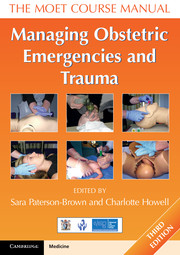Book contents
- Frontmatter
- Dedication
- Contents
- Working Group
- About the authors
- Acknowledgements
- Abbreviations
- Section 1 Introduction
- Section 2 Recognition
- Section 3 Resuscitation
- Section 4 Trauma
- Section 5 Other medical and surgical emergencies
- 21 Abdominal emergencies in pregnancy
- 22 Cardiac, diabetic and neurological emergencies in pregnancy
- 23 Perinatal psychiatric illness
- Section 6 Obstetric emergencies
- Section 7 Triage and transfer
- Section 8 Human issues
- Index
22 - Cardiac, diabetic and neurological emergencies in pregnancy
- Frontmatter
- Dedication
- Contents
- Working Group
- About the authors
- Acknowledgements
- Abbreviations
- Section 1 Introduction
- Section 2 Recognition
- Section 3 Resuscitation
- Section 4 Trauma
- Section 5 Other medical and surgical emergencies
- 21 Abdominal emergencies in pregnancy
- 22 Cardiac, diabetic and neurological emergencies in pregnancy
- 23 Perinatal psychiatric illness
- Section 6 Obstetric emergencies
- Section 7 Triage and transfer
- Section 8 Human issues
- Index
Summary
Objectives
On successfully completing this topic, you will be able to:
understand the serious cardiac, diabetic and neurological problems that can affect pregnant women
anticipate the health problems of women with pre-existing disease
appreciate the critical diagnostic features heralding emergencies in pre-existing and new conditions
take part in the urgent multidisciplinary care of pregnant and puerperal women with complex disorders
understand important aspects of service provision for such women with complex disorders.
Introduction and incidence
The 2006–08 Triennial Confidential Enquiry into maternal deaths (Saving Mothers' Lives) reported a total of 53 deaths from heart disease related to pregnancy. This was an increase from the previous triennium when 48 deaths were reported. Cardiac disease remains the commonest cause of indirect maternal death and also the commonest cause of maternal death overall. Some degree of substandard care was present in 51% of cases.
The same enquiry reported three deaths of women with diabetes mellitus, 0.13 per 100 000 maternities, all probably due to hypoglycaemia. The mortality from diabetes is stable with one death reported in the previous triennium and three in the triennium prior to that. Diabetes is an uncommon cause of indirect maternal death, but the burden of disease is high and growing and emergency complications must be recognised and appropriately managed.
Neurological disease in pregnancy and the puerperium is not singled out in the report as a separate entity. However, the overall recommendations of Saving Mothers' Lives are pertinent. Especially so are the recommendations to take due note of pre-existing disease and to work within a multidisciplinary, specialist team, both to avoid and to treat emergencies in complex cases.
- Type
- Chapter
- Information
- Managing Obstetric Emergencies and TraumaThe MOET Course Manual, pp. 241 - 266Publisher: Cambridge University PressPrint publication year: 2014

